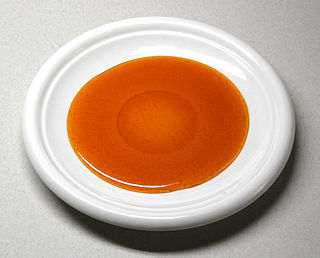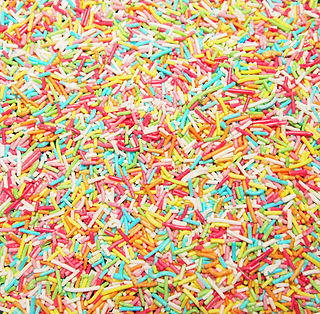
Dessert is a course that concludes a meal. The course consists of sweet foods, such as candy, and possibly a beverage such as dessert wine and liqueur. In some parts of the world, such as Greece and West Africa, and most parts of China, there is no tradition of a dessert course to conclude a meal.

Confectionery is the art of making confections, which are food items that are rich in sugar and carbohydrates. Exact definitions are difficult. In general, however, confectionery is divided into two broad and somewhat overlapping categories: bakers' confections and sugar confections. The occupation of confectioner encompasses the categories of cooking performed by both the French patissier and the confiseur.

Caramel is an orange-brown confectionery product made by heating a range of sugars. It can be used as a flavoring in puddings and desserts, as a filling in bonbons, or as a topping for ice cream and custard.

The Hershey Company, commonly known as Hershey's, is an American multinational company and one of the largest chocolate manufacturers in the world. It also manufactures baked products, such as cookies and cakes, and sells beverages like milkshakes, as well as other products. Its headquarters are in Hershey, Pennsylvania, United States, which is also home to Hersheypark and Hershey's Chocolate World. It was founded by Milton S. Hershey in 1894 as the Hershey Chocolate Company, which is a subsidiary of his Lancaster Caramel Company. The Hershey Trust Company owns a minority stake but retains a majority of the voting power within the company.

Praline is a form of confection containing, at a minimum, culinary nuts – usually almonds, pecans and hazelnuts – and sugar. Cream is a common third ingredient.

York Peppermint Pattie is an American dark chocolate enrobed peppermint confection introduced in 1940 and currently produced by the Hershey Company.

Sprinkles are small pieces of confectionery used as an often colourful decoration or to add texture to desserts such as brownies, cupcakes, doughnuts or ice cream. The tiny candies are produced in a variety of colors and are generally used as a topping or a decorative element. The Dictionary of American Regional English defines them as "tiny balls or rod-shaped bits of candy used as a topping for ice-cream, cakes and other."

Reese's Pieces are a peanut butter candy manufactured by The Hershey Company; they are oblate spheroid in shape and covered in candy shells that are colored yellow, orange, or brown. They can be purchased in plastic packets, cardboard boxes, or cup-shaped travel containers. The Reese company was founded by H.B. Reese. The H.B. Reese Candy Company was merged with The Hershey Company in 1963.

Hershey's Kisses is a brand of chocolate first produced by the Hershey Company in 1907. The bite-sized pieces of chocolate have a distinctive conical shape, sometimes described as flat-bottomed teardrops. Hershey's Kisses chocolates are wrapped in squares of lightweight aluminum foil. A narrow strip of paper sticks out from the top of each Hershey's Kiss wrapper. Originally designed as a flag for the "Hershey's" brand, the printed paper plumes were added to the Kisses product wrapper in 1921 in order to distinguish the Hershey's Kiss from its competitors who offered similar products.

Reese's Peanut Butter Cups are an American candy by The Hershey Company consisting of a peanut butter cup encased in chocolate. They were created on November 15, 1928, by H. B. Reese, a former dairy farmer and shipping foreman for Milton S. Hershey. Reese left his job with Hershey to start his own candy business. Reese's are the top-selling candy brand worldwide, with more than $2 billion in annual sales generated for The Hershey Company.

Almond Joy is a candy bar manufactured by Hershey's, consisting of sweetened, shredded coconut topped with whole almonds and covered in milk chocolate. The company also produces Mounds bars, a similar confection without nuts, coated in dark chocolate.

A fluffernutter is a sandwich made with peanut butter and marshmallow creme usually served on white bread. Variations of the sandwich include the substitution of wheat bread and the addition of various sweet, salty, and savory ingredients. The term fluffernutter can also be used to describe other food items, primarily desserts, that incorporate peanut butter and marshmallow creme.
Fannie May Confection Brands, Inc. is an American chocolate manufacturer headquartered in Chicago and currently owned by Italian company Ferrero SpA. Fannie May manufactures a broad variety of products including enrobed, barks, caramels, squares, berries, twist wrapped, molded, flow wrapped, and boxed chocolates. In attempt to reach all consumers, Fannie May became allergy conscious, carrying candy without gluten, milk, honey, oil(s), wheat, eggs, etc. The Union of Orthodox Jewish Congregations of America certified many of Fannie May's products to be kosher as well.

An icebox cake is a dairy-based dessert made with cream, fruits, nuts, and wafers and set in the refrigerator. One particularly well-known version is the back-of-the-box recipe on thin and dark Nabisco Famous Chocolate Wafers.

Whatchamacallit is a chocolate candy bar marketed in the United States by The Hershey Company.

Mint chocolate is a popular type of chocolate, made by adding a mint flavoring, such as peppermint, spearmint, or crème de menthe, to chocolate. Mint chocolate can be found in a wide variety of edible products, such as candy, mints, cookies, mint chocolate chip ice cream, hot chocolate, and others. In addition, it is marketed in a non-edible form as cosmetics. Depending widely on the ingredients and the process used, mint chocolate can give off a very distinctive mint fragrance. The chocolate component can be milk chocolate, regular dark chocolate, or white chocolate; due to this, mint chocolate has no one specific flavor, and so each chocolate-plus-flavor combination can be unique.

A Dominostein is a confection primarily sold during Christmas season in Germany and Austria.
The following outline is provided as an overview of and topical guide to chocolate:
















